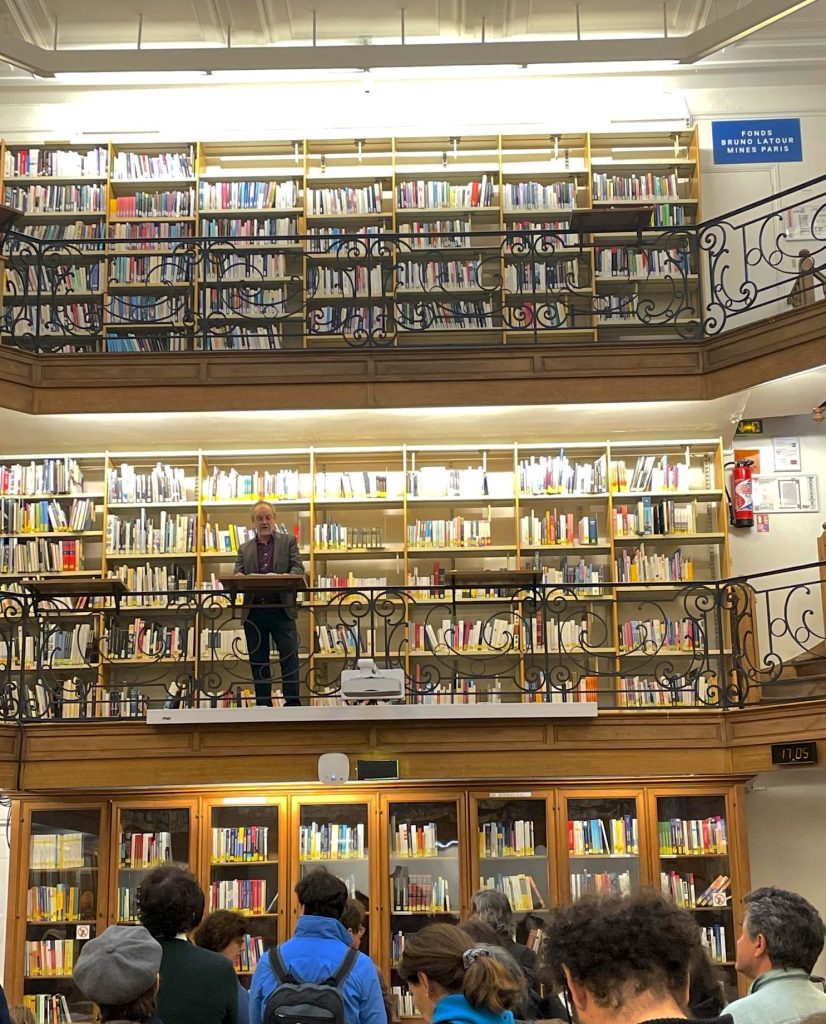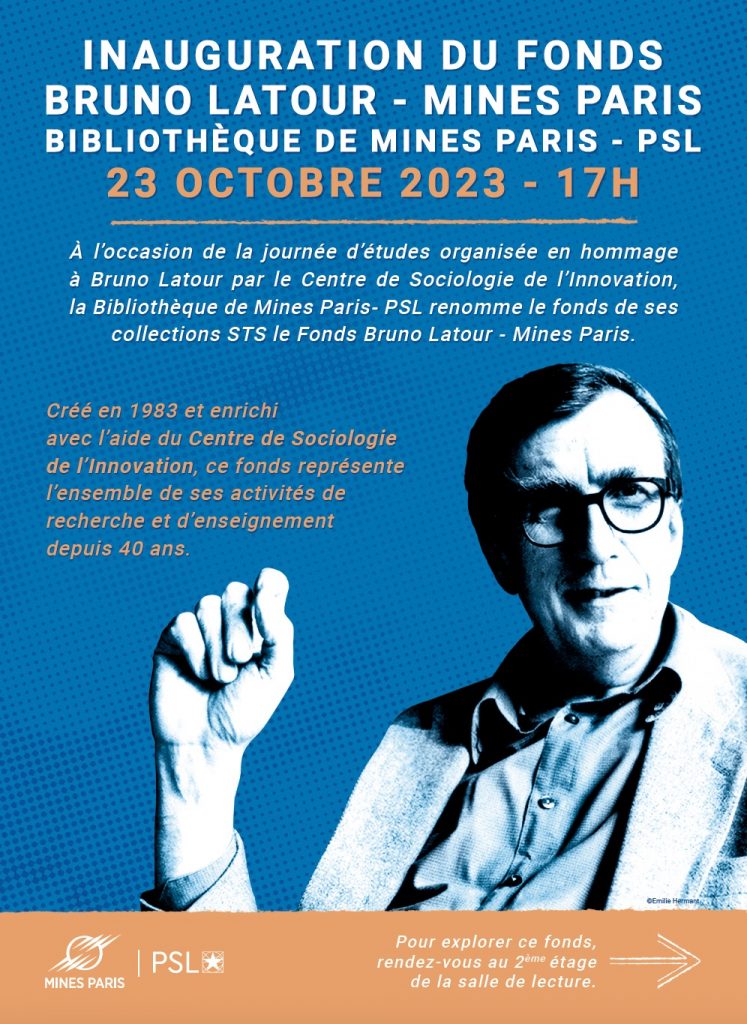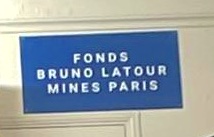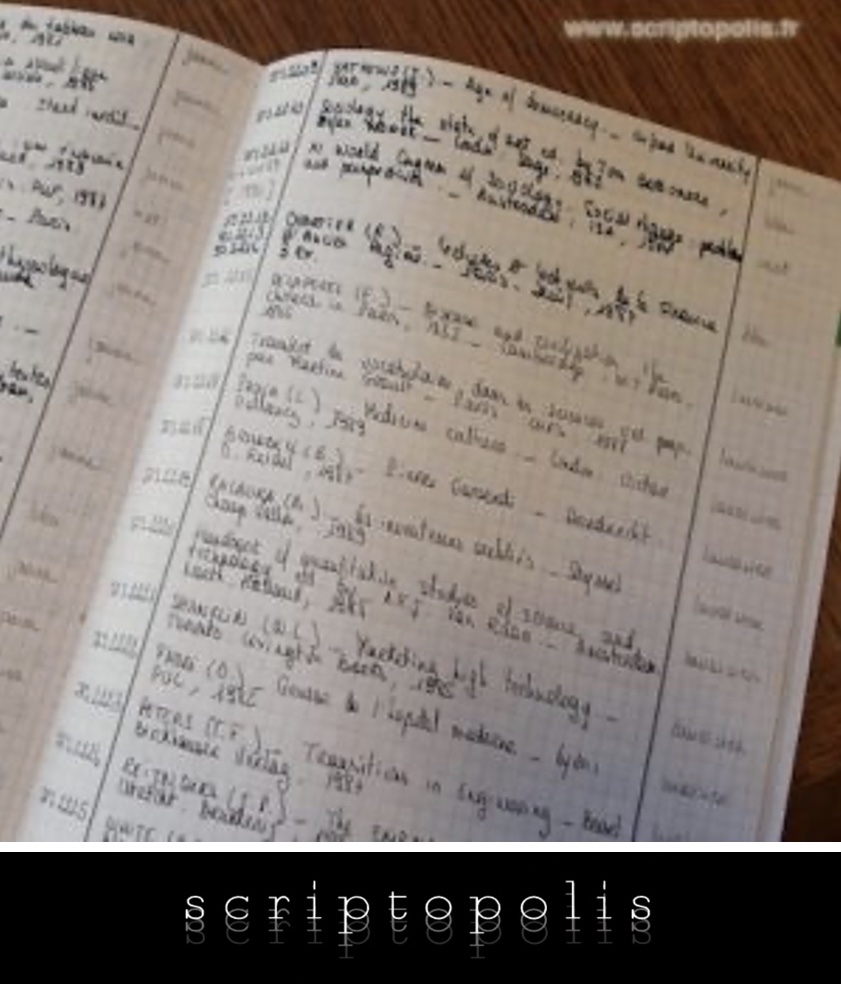École des Mines Library
Address for the inauguration of
the Fonds Bruno Latour – Mines Paris
by Alexandre Mallard, Senior researcher at Mines Paris – PSL, and Director of the CSI from 2013 to 2023.
Good evening to all of you,
As you can see, we took the opportunity of this day of homage to officially and solemnly associate the name of Bruno Latour with a book collection located here at the École des Mines Library, which he played a major part in developing. This collection which we previously called the “Fonds STS” [STS collection] brings together more than 7200 books in social sciences, history, economics, anthropology and philosophy. Its name, as you can imagine, refers the field of Science & Technology Studies – or in French “Sciences, Techniques, Société” – of which Bruno Latour was one of the founders.

The collection includes books on science and technology, but also, of course, on other themes dear to Bruno Latour and the CSI researchers, such as the environment, politics and economics. It was created in 1983, a year after Bruno Latour joined the École des Mines. He wasn’t actually the initiator of the creation of the STS collection, but it was indeed he who, a few years later, ensured the scientific supervision of the supply of this fund, and gave it the form it took from the late 1980s onwards. One of the features of the collection, which is still in force, is that it is supplied by CSI researchers, who indicate to the library which books to order. Of course, the library also has its own ordering policy for books on all subjects, including science and technology.
The creation of the STS collection is an interesting case of hybridization between the social sciences and industry, since it was initially financed by a donation from the Schlumberger family, and more specifically from Anne Gruner. Anne Gruner was the daughter of Conrad Schlumberger, a famous French industrialist, mines engineer, professor at the École des Mines de Paris, and founder of a company that would later become the Schlumberger multinational. From the mid-1960s onwards, Anne Gruner developed a series of patronage initiatives in favor of reading, art, science and music. Bruno Latour got in touch with her around 1986, and from their dialogue emerged the idea of financing the acquisition of books for the École des Mines library. The Schlumberger family donated one million francs to the École des Mines Foundation, which was invested and the interest used for the acquisitions.
The history of this collection, resulting from an encounter between a philosopher and the daughter of a major industrialist, will not come as a complete surprise to those who have read Bruno Latour’s book Les microbes, Guerre et Paix (Métailié, 1984) [The Pasteurization of France, Harvard University Press, 1988], dedicated to Louis Pasteur’s discoveries. Latour describes how Pasteur actively approached Louis Napoléon Bonaparte so that he could finance the research that led to the “discovery” of the rabies virus. From experience, Latour knew that great researchers need to be able to attract the favor of politicians or industrialists to bring their projects to fruition.
How can we understand the project Bruno Latour was pursuing with the creation of the STS fund?

I will begin with the “educational” dimension of this work. We can undoubtedly say that when Bruno Latour “landed” at an engineering school in the early 1980s – and one of the most prestigious in France – he took seriously the educational mission that fate had assigned him. He had long been aware of the ignorance or indifference of people in science and industry with regard to the history of scientific and technical objects, and to the way in which these alter social relations. Part of the educational projects he developed here were aimed precisely at nurturing the relationship between future engineers and the very objects of science and technology. The study of controversies, through the course developed with Michel Callon, is a trace of this effort that is often cited. Getting future engineers to read books on the history and sociology of science and technology, thanks in particular to the STS collection, is another. If the endeavor was noble, Latour also knew it was perilous. To be convinced of this, simply pay attention to this joke at the beginning of Aramis ou l’amour des techniques (La Découverte, 1992) [Aramis or The Love of Technology, Harvard University Press, 1996], one of the books Latour wrote while he was at École des Mines. He stages himself in an investigation intended to elucidate the failure of a revolutionary métro project, accompanied by a young engineer tasked to assist him in conducting interviews with transport industry executives. When he asks this assistant to begin his work by reading a whole series of books on the history of transport, he is confronted with an incomprehension. I quote Latour: “Getting an engineer to read books? The shock was rather harsh”. The STS fund was undeniably a way of cushioning this shock, and we can say that almost forty years on, we are continuing this “cushioning” by having engineering students of the school read social science books that originate from it.
But beyond its pedagogical uses, for Bruno Latour the STS fund was also, and above all, a central tool in the research work. To shed light on his conception of the role of such a device in scientific work, one can read a chapter he wrote in a collective book published in 1996, and dedicated to “the power of libraries”[1]. The title of this chapter is in itself quite a program: “These networks that reason ignores: laboratories, libraries, collections”. In this brilliant text, we find a condensed version of the argument he had developed over several hundred pages in La science en action (La Découverte, 1989) [Science in Action: How to Follow Scientists and Engineers Through Society, Harvard University Press, 1988]. The chapter is richly illustrated, with iconography in the purest Latourian style, and prose that is no less Latourian. In one sentence, we learn that he was a “frustrated user of French libraries” – Latour had frequented the libraries of the Anglo-Saxon academic world, which at the time offered services incomparable to those of French libraries. In particular, the chapter deals with his conception of the library as a research device:
“As we can see, a library considered as a laboratory cannot remain isolated, as if it were accumulating signs by the millions in a manic, erudite and cultivated way. Rather, it serves as a marshalling yard, a bank that plays for the world of networks and centers the role of Wall Street or the City for capitalism. To take another example, it appears in this description as a large instrument of physics, like the CERN accelerators, obtaining within them extreme conditions, which redistribute the properties of phenomena subjected to tests that exist nowhere else and that giant detectors built for the occasion are able to capture, locate and amplify.”
Here, the library is compared to a bank, a marshalling yard, a particle accelerator – metaphors that tell us implicitly things about the STS collection, and which I would like to comment on briefly. As far as the bank is concerned, I will just say that we can probably see here a wish that the users of the STS collection can become, like all researchers, good science capitalists. Now the particle accelerator. It seems to me that this idea that the gathering of a series of books in the concentrated space of a library can somehow help produce sparks, like those that ignite in an accelerator, clearly evokes Bruno Latour’s relationship with bookish knowledge. Though the extent of this knowledge will have struck all his readers, notions such as encyclopedism or erudition do little to convey its nature. Rather, this relationship is characterized by an incredible ability to relate, to “make connections” between ideas coming from very different horizons. So the STS fund had to be capable of generating such sparks. Lastly, I like the idea of a “marshalling yard”, because it evokes the multiplicity of paths, that through a library, can be established between those who write books and those who read them, between those who build collections and those who borrow books from them. The fact that the STS fund is itself backed by a laboratory, the CSI, makes this marshalling yard even more special: on the one hand, because the sorting and redirection possibilities benefit from the strength of the collective which feeds the fund, and on the other hand, because this configuration speeds up these transfer operations, bringing what Bruno Latour called the “research front” closer to the diverse audiences the library may have. The books in the collection are, in fact, those identified by researchers as relevant to the research currently underway.

As we also learned from Bruno Latour, our knowledge of things remains definitively incomplete until we penetrate their materiality. It is from this viewpoint that I would now like to make a few observations. The STS fund is located on the second floor of the Mines Paris library, and it’s interesting to note that for the engineer or researcher in search of a book, the path to knowledge starts with a spiral movement, as you first have to take the small staircase at the back to access the bookshelves. Once you have reached the second floor, you will have a particularly pleasant bird’s-eye view of the whole room and the other collections, which could intrigue any connoisseur of Bruno Latour’s work. Indeed, Latour who had taught us so much about the benefits of horizontal thinking, and warned us of the perils of any overhanging position, may well have found the idea of having to rise to the heights of this room to gain access to knowledge about science and technology, and thereby dominate the other collections, a bit of revenge for the social sciences, often ranked at the bottom of the hierarchy of scientific disciplines.
Once the sensation of dizziness has been mastered, the user of the STS collection will undoubtedly be amazed by its rating system: the books are indexed in order of their arrival in the collection. The first book is indexed as STS 0001, and the last as STS 7793. Such a system, which leaves no room for thematic classification, is undeniably a provocation for any library professional familiar with thematic classification. We are grateful to the people in charge of this department at the École for tolerating the persistence of such an oddity in the heart of their jurisdiction. A few years ago, one of our doctoral students expressed her amazement and disapproval on discovering that the famous STS collection she had heard so much about was filed in a completely disorganized way. A colleague from the CSI was quick to explain that, on the contrary, an order was quite identifiable and highly meaningful : by linearly following the bookshelves, one could travel the time scale and decipher the evolution of the research issues addressed by CSI researchers. It is thus possible to read the evolution of the STS field through a certain prism. I don’t think Bruno Latour minded the absence of a thematic classification system: any thematic classification carries the risk of freezing the collections in the organization of knowledge of a given period. In order to preserve the power at the marshalling yard, it was undoubtedly not necessary to encase the immutable mobiles that books are in a thematic classification, their compartmentalization would have restricted the circulation paths and limited the possibility of bifurcation. Bruno Latour believed much more in the virtues of keyword indexing, and in the early years of the collection’s creation, he devoted a great deal of attention to the development of a database indexed with keywords allowing the most diverse searches within the collection.

A presentation of the STS collection would most certainly be incomplete without a brief overview of the books. To give such an overview, I will mention seven of them. As you can imagine, this is a personal choice, but one that I think will be evocative for all connoisseurs of Bruno Latour’s work, particularly in the period during which he was at the École des Mines
1. Under call number STS 262 is Studies in ethnomethodology by Harold Garfinkel, published in 1967 (Prentice-Hall). The fairly demanding passage through ethnomethodology was part of the ordinary initiatory path in STS training at the CSI doctoral workshop.
2. Under call number STS 1546 is a book Bruno Latour considered an essential reference in the field of STS: Leviathan and the Air-Pump: Hobbes, Boyle, and the Experimental Life by Steven Shapin and Simon Schaffer, released in 1985 (Princeton University Press).

3. Call number STS 1772 is for the book by the anthropologist Jack Goody La raison graphique : la domestication de la pensée sauvage, published in 1978 (Éditions de Minuit) [The Domestication of the Savage Mind, Cambridge University Press, 1977]. According to Bruno Latour, the book contained an important revelation: proof of the materiality of the intellectual operations that run through science and technology.
4. Under call number STS 3577 is a book written by a philosopher with whom Bruno Latour maintained the fruitful dialogue we all know: L’invention des sciences modernes by Isabelle Stengers, published in 1993 (La Découverte) [The Invention of Modern Science, University of Minnesota Press, 2000].
5. Under call number STS 3614 is Science on the run : information management and industrial geophysics at Schlumberger 1920-1940, published in 1994 (The MIT Press) by Geof Bowker. Bowker is a well-known researcher in STS, but today he is mainly cited for his later work, particularly on classification issues. In fact, one of Geof Bowker’s first research projects was carried out at the École des Mines, in the 1980s, using Schlumberger’s archives. Through this book (and a few others, notably Anne Gruner’s books), the STS collection gives something back of what it owes to the Schlumberger family who contributed to its existence.
6. Under call number STS 500 is Science and the modern world : Lowell lectures by Alfred Whitehead, published in 1925 (Macmillan), a book that opens with a small enigma. Indeed, philosophers familiar with Latour generally consider that it was rather late, towards the end of the 1990s, that Whitehead’s philosophy began to irrigate Bruno Latour’s thinking. How, then, can we explain the fact that the book has been in the collection since the late 1980s? Was it acquired by another of the center’s researchers, or did it wait a good ten years before arousing his curiosity, like a fine wine that has aged in a cellar?
7. Finally, call number STS 7793 is for a book by Dimitris Papadopoulos entitled Experimental practice : technoscience, alterontologies, and more-than-social movements released in 2018 (Duke University Press). Bruno Latour did not ordered its acquisition, but what I would like to emphasize here is that its presence in the collection clearly reflects the persistence, in the research carried out at the École des Mines, of an interest in the interweaving of scientific experimentation and society that lay at the origin of the STS field.
Thank you for your attention, and to conclude, I would just like to say “the STS collection is dead, long live the Fonds Bruno Latour – Mines Paris”.
École des Mines de Paris, October 23, 2023.
[1] Bruno Latour, 1996, “Ces réseaux que la raison ignore – laboratoires, bibliothèques, collections“, in Christian Jacob et Marc Baratin, Le pouvoir des bibliothèques. La mémoire des livres dans la culture occidentale, Albin Michel, pp. 23-46.

The inauguration of the Fonds Bruno Latour Mines-Paris was prepared under the guidance of Clarisse Pradel, head of the Paris library, with Pascale Nalon, head of the Fontainebleau library, Amélie Masson, documentalist, and Ludovic Bouvier, archivist.
Portal of the library of Mines Paris-PSL
Inauguration

by Florence Paterson and Clarisse Pradel, scriptopolis.fr
[Reading 2 min]
The history of the Fonds Bruno Latour Mines-Paris holds its share of mystery…
